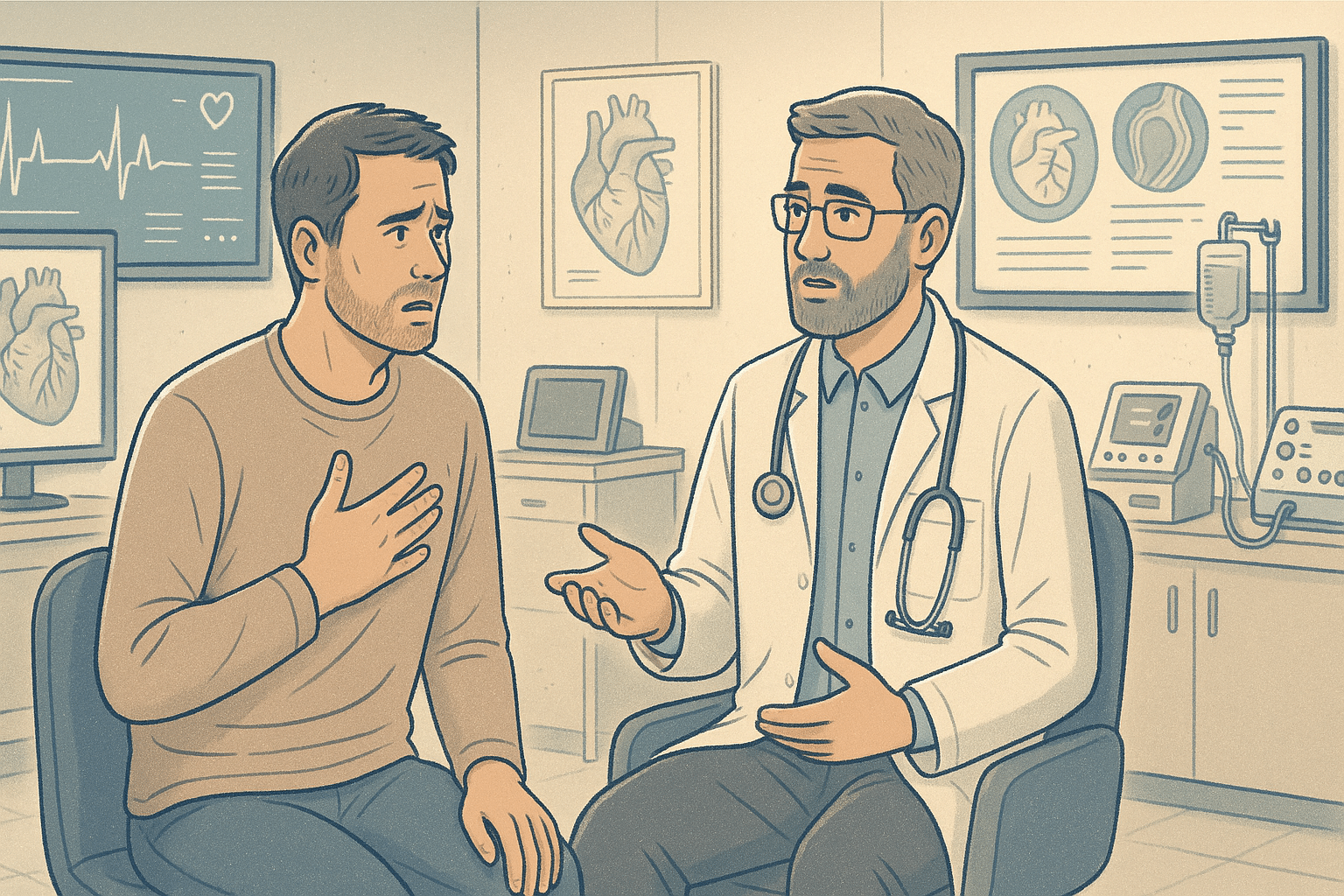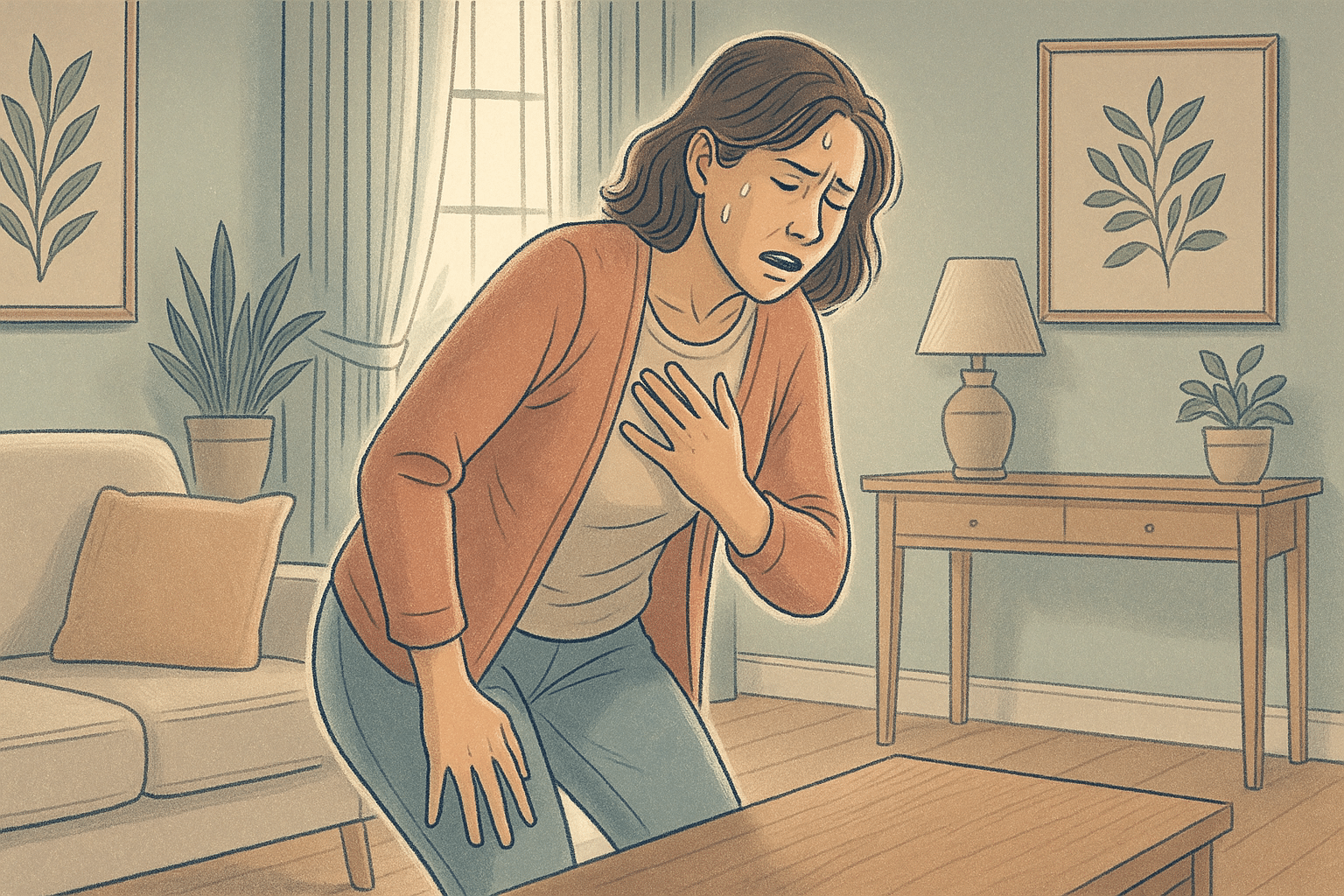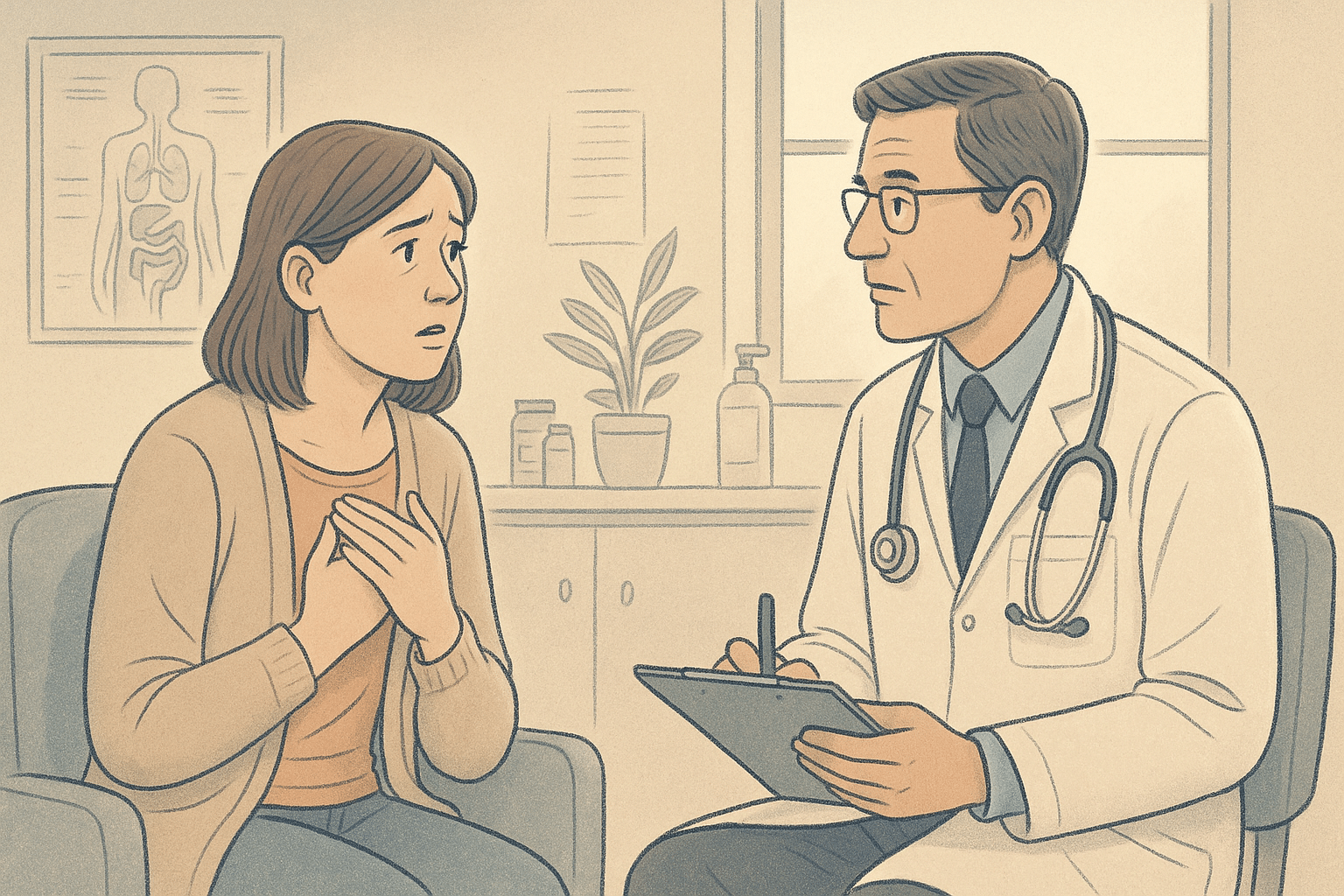Key Takeaways
- Heart conditions like atrial fibrillation and POTS syndrome can produce symptoms nearly identical to panic attacks, leading to misdiagnosis and delayed treatment.
- Physical triggers, symptom duration, and responses to interventions can help distinguish between cardiac conditions and anxiety disorders.
- Tracking symptoms with specific details about timing, triggers, and associated factors can be crucial for your healthcare provider to make an accurate diagnosis.
- Even if you have a history of anxiety, new or different symptoms should always be evaluated by a medical professional to rule out underlying heart conditions.
- At A Mission for Michael, we understand the complex relationship between physical and mental health symptoms and provide comprehensive evaluation for proper diagnosis.
When Your Heart Mimics Anxiety
The human body’s alarm systems work in mysterious ways. Both panic attacks and cardiac events trigger the same fight-or-flight response, flooding your system with adrenaline and causing a cascade of physical reactions. Your heart pounds, breathing quickens, you might feel lightheaded or nauseated, and an overwhelming sense of doom can take hold.
These experiences feel frighteningly similar whether they originate from your heart or your brain. Understanding this overlap is crucial because misdiagnosis happens frequently in both directions.
Founded in 2010, A Mission For Michael (AMFM) offers specialized mental health care across California, Minnesota, and Virginia. Our accredited facilities provide residential and outpatient programs, utilizing evidence-based therapies such as CBT, DBT, and EMDR.
Our dedicated team of licensed professionals ensures every client receives the best care possible, supported by accreditation from The Joint Commission. We are committed to safety and personalized treatment plans.
Why Heart Problems Get Misdiagnosed
Overlapping Symptoms
The symptom overlap between panic attacks and heart conditions is extensive. Both can cause chest pain, racing heart, shortness of breath, dizziness, and fatigue. Both can wake you from sleep. Both can make you feel like you’re dying. This similarity isn’t coincidental; it reflects how our nervous system responds to perceived threats, whether those threats are physical or psychological in nature.
This is why telling someone having a panic attack that “it’s all in your head” is both inaccurate and unhelpful, the physical symptoms are very real, regardless of their origin.
Diagnostic Challenges

Even with modern medical technology, diagnosing certain heart conditions can be challenging.
Some cardiac issues only appear during episodes, meaning they might not show up during a standard electrocardiogram (ECG) if you’re not experiencing symptoms at that moment. Additionally, stress tests might not reveal problems that occur during rest or sleep.
Adding to this complexity, having anxiety doesn’t mean you can’t also have a heart condition. In fact, chronic anxiety and stress can contribute to cardiovascular problems over time. The two conditions can exist simultaneously and even exacerbate each other, creating a challenging diagnostic picture for healthcare providers.
Risk Factors
Certain factors increase the likelihood that symptoms might be cardiac in nature rather than anxiety-related. These include age over 40, known cardiovascular risk factors like high blood pressure or cholesterol, family history of heart disease, and symptoms that specifically occur during physical exertion.
However, the absence of these risk factors doesn’t guarantee that symptoms are not cardiac. Heart conditions can affect people of any age and fitness level.
5 Heart Conditions That Mimic Panic Attacks
1. Atrial Fibrillation
Atrial fibrillation (AFib) is one of the most common heart conditions that patients confuse with panic attacks. This cardiac arrhythmia causes the upper chambers of your heart to beat irregularly and often rapidly. During an AFib episode, you might experience heart palpitations, shortness of breath, weakness, fatigue, and lightheadedness, symptoms strikingly similar to anxiety attacks.
The unpredictability of AFib episodes can also trigger genuine anxiety, creating a cycle where the heart condition and emotional response feed into each other.
Key Differences
While panic attacks typically build quickly and peak within minutes, AFib episodes can develop more gradually and persist for hours or even days. Another telling difference is that AFib symptoms rarely include some of the classic panic symptoms like a sense of detachment or fear of losing control.
Additionally, AFib may improve with specific physical maneuvers that affect your vagus nerve, such as bearing down as if having a bowel movement or splashing cold water on your face, techniques that typically have minimal effect on panic attacks.
Perhaps most significantly, AFib symptoms typically don’t improve with anti-anxiety techniques like deep breathing or grounding exercises. If you’ve been diagnosed with panic disorder but find that calming techniques don’t help resolve your episodes, this could be a sign that something else is happening.
2. Mitral Valve Prolapse
Mitral valve prolapse (MVP) occurs when the valve between your heart’s left chambers doesn’t close properly, sometimes allowing blood to flow backward. While many people with MVP have no symptoms, others experience palpitations, chest discomfort, fatigue, and shortness of breath that can closely mimic anxiety attacks.
What makes MVP particularly challenging to distinguish from anxiety is that stress and anxiety can actually trigger or worsen MVP symptoms, creating a confusing overlap between the physical condition and emotional response.
Distinguishing Features
One key difference between MVP and panic attacks is that a healthcare provider can often detect MVP through auscultation; listening to your heart with a stethoscope. The characteristic “mid-systolic click” followed by a murmur provides objective evidence of the valve condition.
Additionally, symptoms of MVP may persist at a low level for extended periods, rather than coming in discrete episodes with clear beginnings and endings as panic attacks typically do. Echocardiography (an ultrasound of the heart) can definitively diagnose MVP by visualizing the abnormal valve movement. If you’ve been diagnosed with anxiety but your symptoms persist despite appropriate psychological treatment, requesting this non-invasive test may help rule out MVP as a contributing factor to your symptoms.
3. Supraventricular Tachycardia
Supraventricular tachycardia (SVT) is a condition where your heart suddenly races, often reaching 150–250 beats per minute. Unlike the gradual buildup of a panic attack, SVT typically starts and stops abruptly.
This sudden onset can be terrifying, triggering a genuine panic response on top of the physical symptoms, making it even harder to distinguish from primary anxiety disorders.
Trigger Patterns
While panic attacks are often triggered by psychological stressors, SVT episodes frequently occur during physical activities, after consuming caffeine or alcohol, or seemingly at random with no clear trigger.

Some patients notice SVT episodes happen during position changes or after straining.
The unpredictable nature of these episodes can lead to anticipatory anxiety as patients begin to fear when the next episode might strike, creating a complex interplay between the physical condition and psychological response.
4. Coronary Artery Disease
While most people associate coronary artery disease (CAD) with crushing chest pain, many patients, particularly women, older adults, and people with diabetes, experience atypical symptoms that can mimic anxiety.
These include shortness of breath, fatigue, nausea, and a sense of dread or doom. The overlap between these symptoms and those of panic disorder can lead to dangerous misdiagnosis, especially in populations traditionally considered lower risk for heart disease.
Warning Signs
Pay close attention if you notice symptoms primarily during physical exertion that consistently improve with rest. This pattern suggests a physical rather than psychological cause.
Similarly, symptoms that gradually worsen over time, rather than remaining at the same intensity as many chronic anxiety conditions do, warrant cardiac evaluation. Unexplained sweating, particularly if it’s cold and clammy rather than the warm flushing often associated with anxiety, can also signal CAD rather than panic.
5. POTS Syndrome
Postural Orthostatic Tachycardia Syndrome (POTS) is a form of dysautonomia that causes an abnormal increase in heart rate when moving from lying to standing. This condition frequently goes undiagnosed for years, with patients often labeled as having anxiety disorders instead.
The racing heart, dizziness, brain fog, fatigue, and shortness of breath that characterize POTS can almost perfectly mimic panic attacks, but stem from a physical dysfunction of the autonomic nervous system rather than psychological causes.
Positional Symptoms
The hallmark of POTS is symptoms that worsen when upright and improve when lying down. Patients typically experience a spike in heart rate (at least 30 beats per minute increase) within 10 minutes of standing, without a significant drop in blood pressure. This positional change may trigger lightheadedness, visual changes, cognitive difficulties (“brain fog”), nausea, and fatigue, a constellation of symptoms often mistakenly attributed to anxiety or panic.
Many POTS patients report that their symptoms are worse in the morning, after hot showers, during hot weather, or following meals, patterns that aren’t typically seen with primary anxiety disorders. This positional and situational component provides important clues that something beyond anxiety may be occurring.
Tell-Tale Differences
Physical vs. Mental Triggers
Cardiac symptoms often occur in relation to physical activities or states: during exertion, after meals, with position changes, or during sleep. In contrast, panic attacks more commonly (though not exclusively) relate to psychological triggers: stressful situations, specific fears, or sometimes seemingly random moments when worry spirals. Paying close attention to what you were doing when symptoms began can provide valuable diagnostic clues.
Duration Patterns
Panic attacks typically follow a predictable pattern: rapid onset, peak within about 10 minutes, and gradual resolution within 20–30 minutes. Heart conditions often show different timing, AFib may persist for hours or days, CAD symptoms might consistently occur with exertion and improve with rest, and POTS symptoms typically relate to positional changes and can persist as long as the person remains upright.
Episodes that don’t follow the typical panic attack timeline warrant further investigation. Similarly, symptoms that don’t respond to anxiety management techniques or anti-anxiety medications suggest a possible physical cause rather than primary anxiety disorder.
Response to Interventions
How symptoms respond to various interventions can provide valuable diagnostic information. Panic symptoms often improve with deep breathing, grounding techniques, and anti-anxiety medications.
By contrast, cardiac symptoms typically don’t respond to these approaches but may improve with specific interventions like changing position, vagal maneuvers (such as bearing down or cold water to the face for some arrhythmias), or cardiac-specific medications.
Getting a Proper Diagnosis

If you’re experiencing symptoms that could be either cardiac or anxiety-related, pursuing proper diagnosis is essential.
Getting a proper diagnosis often requires persistence, especially if you’ve previously been labeled as having anxiety. Having an anxiety diagnosis doesn’t make you immune to heart problems; both can exist simultaneously, and one can exacerbate the other.
At A Mission for Michael, we take a comprehensive approach to diagnosis, considering both physical and psychological factors. We believe patients’ symptoms deserve thorough investigation rather than premature attribution to anxiety, which happens all too frequently in conventional healthcare settings.
Comprehensive Heart-Mind Assessment at AMFM
At AMFM, we recognize that the intersection of cardiac and psychological symptoms requires specialized expertise. Our integrated approach ensures you receive comprehensive evaluation that honors both the physical and emotional aspects of your experience.
Our clinical team collaborates with cardiac specialists when needed, ensuring that no stone is left unturned in identifying the true source of your symptoms. We understand that having an anxiety diagnosis doesn’t make you immune to heart problems, and conversely, that cardiac conditions often trigger legitimate anxiety responses. This nuanced understanding allows us to develop treatment plans that address your complete health picture rather than treating symptoms in isolation.

With treatment facilities in California, Virginia, and Washington we ensure you’re well taken care of while going through comprehensive evaluation.
Don’t let uncertainty about your symptoms prevent you from getting the help you deserve. Contact AMFM today for an evaluation that considers every possibility and provides the clarity you need to move forward with confidence.
Frequently Asked Questions (FAQ)
Can anxiety cause heart damage?
Chronic anxiety and stress can potentially contribute to heart problems over time. Persistent elevation of stress hormones like adrenaline and cortisol can increase blood pressure, promote inflammation, and affect heart rhythm. However, the occasional panic attack in an otherwise healthy person is unlikely to cause permanent heart damage.
How do I know if chest pain is serious?
Chest pain that is severe, crushing, or squeezing, especially if it radiates to the jaw, arm, or back, warrants immediate medical attention. Other concerning features include chest pain accompanied by shortness of breath, nausea, vomiting, dizziness, or fainting. Chest discomfort that occurs with exertion and improves with rest should also prompt medical evaluation. It’s always safer to have chest pain evaluated professionally rather than assuming it’s not serious.
Are heart palpitations always dangerous?
Occasional heart palpitations, sensations of your heart racing, pounding, or skipping beats, are common and often benign, especially if they’re brief and infrequent. Most people experience palpitations at some point, often related to stress, caffeine, alcohol, or lack of sleep. However, palpitations that occur frequently, last for extended periods, cause lightheadedness or fainting, or occur with chest pain or shortness of breath warrant medical evaluation.
Can panic attacks trigger heart conditions?
While a panic attack itself doesn’t typically cause heart disease, the surge of stress hormones during frequent or severe panic attacks may potentially impact cardiovascular health over time. More importantly, panic disorder and heart conditions often coexist, with each potentially exacerbating the other. The physical stress of a panic attack can unmask underlying cardiac issues that were previously asymptomatic.
How does AMFM help distinguish between heart conditions and panic attacks?
AMFM takes a comprehensive, integrated approach to evaluation that considers both physical and psychological factors rather than assuming symptoms are entirely one or the other. Our experienced team conducts thorough assessments, helps coordinate appropriate cardiac testing when indicated, and works collaboratively with medical providers to ensure accurate diagnosis.












